★★½
“Sea minus.”
 I love reading IMDb reviews where half are “totally brilliant film-making!” [obviously by people related to the production, who have generally reviewed nothing else] and half are “worst movie ever!” More than half the votes here are either 10’s or 1’s: of course, the truth lies in the middle. This is proficient, with occasional aspirations to competence, along with some nice production values and scenery, yet founders mostly on a bad script, partly on a misguided belief that filming underwater is interesting, in and by itself. That probably hasn’t been true since Jacques-Yves Cousteau hung up his Undersea World snorkel at the start of the eighties. Maybe these sequences worked better in 3D, as originally shot?
I love reading IMDb reviews where half are “totally brilliant film-making!” [obviously by people related to the production, who have generally reviewed nothing else] and half are “worst movie ever!” More than half the votes here are either 10’s or 1’s: of course, the truth lies in the middle. This is proficient, with occasional aspirations to competence, along with some nice production values and scenery, yet founders mostly on a bad script, partly on a misguided belief that filming underwater is interesting, in and by itself. That probably hasn’t been true since Jacques-Yves Cousteau hung up his Undersea World snorkel at the start of the eighties. Maybe these sequences worked better in 3D, as originally shot?
It’s the story of two sisters, Amy (Pham) and Jess (Ong): the former is a free-diving champion, but the latter refuses to go into the sea [there are reasons for this, explained in flashback; they are, however, irrelevant. Of course, her hydrophobia is an obvious foreshadow of the movie’s climax]. Amy’s boyfriend is in the Air Force, but vanishes along with his plane, transporting a cargo of gold back to Manilla. The Air Force suspect he and Amy may have staged the disappearance to solve their financial problems, and so the sisters head for where reports indicate the aircraft went down. Which isn’t anywhere near where the search is taking place. Hmm. There, they team up with a local businesswoman (Prudent), and also travel journalist, Benny Simpson (director Gleissner pulling double-duty), only to find they are not the only people interested in recovering the golden treasure.
I’m not the only person to have reviewed this and been reminded of the work of Andy Sidaris, with which it shares a tropical location and actresses cast more for their looks than their variable thespian abilities. This does have a glossier sheen; on the other hand, if you’re hoping for any nudity, look elsewhere. I think the main problem is the old “acting in your second language” issue, which appears to be the case for most of the cast. Pham has to do most of the heavy lifting, and nails only about one line in three, with others sounding more as if they are delivered through phonetic translation. When things are in motion and SCUBA-free, the film fares rather better. The action scenes are decently staged, the pick likely being Amy getting chased around a library by a slew of thugs, though the final ship-board encounter is nicely done as well. However, embarrassing sloppiness counters this, such an abduction scene where it looks like the same henchman climbs into the car twice, once in the back and once in the front, while Amy’s hands mysteriously get bound, albeit with the sort of constraint she can literally shake off.
It works mostly as a very nice promotional piece for the local tourist board, and if you’re looking for something pleasant looking and possessing absolutely no depth, you could do a lot worse. However, the more you look at this in detail, the more you will likely find yourself going, “Hang on…”, and that’s even before a final credits sequence where the actual local mayor reveals some kinda important storyline information. It’s just another part of a plot which strains even my credulity, and leaves the movie, if not sunk, certainly holed below the waterline.
Dir: Michael Gleissner
Star: Bebe Pham, Jaymee Ong, Michael Gleissner, Laury Prudent





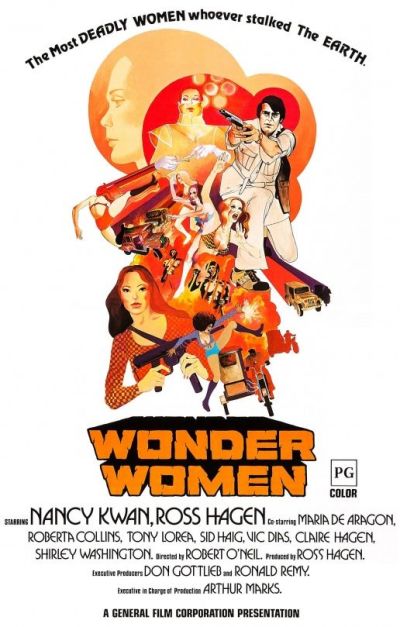 Roger Corman’s New World Pictures weren’t the only ones using the Philippines as a factory to churn out B-movies in the seventies, as this 1973 entry, from Arthur Marks’ General Film Corproration shows. Dr. Tsu (Kwan) and her posse of henchwomen are kidnapping athletes, the not-so-good doctor having perfected the ability to do brain transplants. She’s now selling this as a service to rich, old people, who can become young again. However, after kidnapping a jai-alai star, the insurance company on the hook for the half million dollar policy hires Mike Harber (Hagen) to investigate. As he starts nosing around and making waves, first the local gangster boss, then Dr. Tsu, send their minions out to stop him. Needless to say, this is of limited success, and he is soon on his way to the remote island where Tsu operates, to take down her operation.
Roger Corman’s New World Pictures weren’t the only ones using the Philippines as a factory to churn out B-movies in the seventies, as this 1973 entry, from Arthur Marks’ General Film Corproration shows. Dr. Tsu (Kwan) and her posse of henchwomen are kidnapping athletes, the not-so-good doctor having perfected the ability to do brain transplants. She’s now selling this as a service to rich, old people, who can become young again. However, after kidnapping a jai-alai star, the insurance company on the hook for the half million dollar policy hires Mike Harber (Hagen) to investigate. As he starts nosing around and making waves, first the local gangster boss, then Dr. Tsu, send their minions out to stop him. Needless to say, this is of limited success, and he is soon on his way to the remote island where Tsu operates, to take down her operation.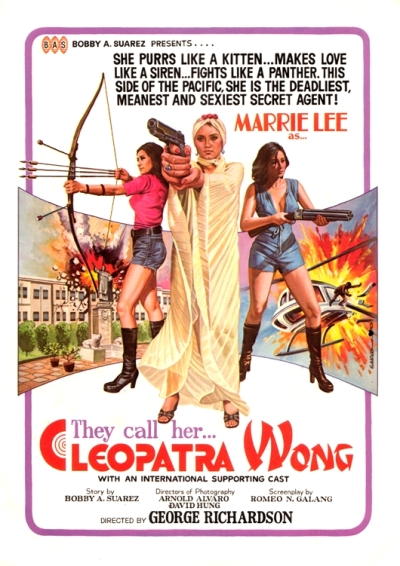 “Cleopatra Wong is Asian Interpol’s answer to James Bond, Flint, Cleopatra Jones and Stacey.” Well, less an answer, more like a repetition of the question, since this is firmly in “cheap Asian knock-off” market, though has some charm in its first half. Wong (Lee) is an agent, assigned to investigate a flood of near-undetectable counterfeit money which is flooding the markets in Hong Kong, the Philippines and elsewhere in the far East. It’s happening in such volume, there’s potential to destabilize the entire economies of the affected countries. She takes down the Singapore branch of the operation, and then discovers the money is being transported in shipments of strawberry jam, emanating from a monastery north of Manilla. After finding them to be not exactly a social order, Wong takes pictures by flying over their compound, which shows that these nuns have some nasty habits – specifically, they’re brothers rather than sisters, and concealing automatic weapons under their vestments. Time for Cleo to assemble and lead a team of crack agent in a raid on the convent, take out the bad guys, rescue the real nuns and save the world for free-market capitalism.
“Cleopatra Wong is Asian Interpol’s answer to James Bond, Flint, Cleopatra Jones and Stacey.” Well, less an answer, more like a repetition of the question, since this is firmly in “cheap Asian knock-off” market, though has some charm in its first half. Wong (Lee) is an agent, assigned to investigate a flood of near-undetectable counterfeit money which is flooding the markets in Hong Kong, the Philippines and elsewhere in the far East. It’s happening in such volume, there’s potential to destabilize the entire economies of the affected countries. She takes down the Singapore branch of the operation, and then discovers the money is being transported in shipments of strawberry jam, emanating from a monastery north of Manilla. After finding them to be not exactly a social order, Wong takes pictures by flying over their compound, which shows that these nuns have some nasty habits – specifically, they’re brothers rather than sisters, and concealing automatic weapons under their vestments. Time for Cleo to assemble and lead a team of crack agent in a raid on the convent, take out the bad guys, rescue the real nuns and save the world for free-market capitalism.

 This was also released in a hardcore version as Black Lolita, but I’m not sure if that was 3D or not. Certainly, the DVD delivers about the worst such attempt I’ve ever seen. It’s in color, but also attempts the red/green method (glasses very early, and the only thing to be said for them is, they stop you seeing the film, which on the whole, is probably no bad thing. Lolita (Love) decides to team up with an air-stewardess and a yoga instructress to take down the local Mr. Big, who goes by the name Buddha – even though about all he shares with the Enlightened One is being Asian, since he’s neither fat nor pacifist.
This was also released in a hardcore version as Black Lolita, but I’m not sure if that was 3D or not. Certainly, the DVD delivers about the worst such attempt I’ve ever seen. It’s in color, but also attempts the red/green method (glasses very early, and the only thing to be said for them is, they stop you seeing the film, which on the whole, is probably no bad thing. Lolita (Love) decides to team up with an air-stewardess and a yoga instructress to take down the local Mr. Big, who goes by the name Buddha – even though about all he shares with the Enlightened One is being Asian, since he’s neither fat nor pacifist. While there’s no denying the
While there’s no denying the 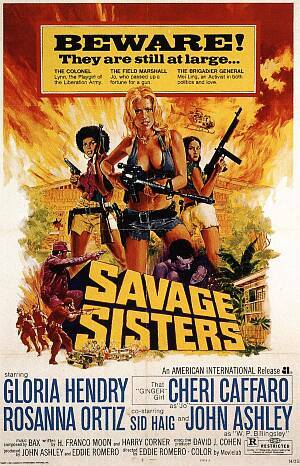 This Philippino phlick doesn’t quite have the courage of its convictions, and is never quite sure whether it wants to be sexploitation or serious drama. The poster promises a lot more than the film actually delivers, which is a shame, as the performances from the three leading ladies are nicely judged – as well as refreshingly multicultural. Two of them (Caffaro and Ortiz, one Caucasian, the other “Oriental”) are sent to prison, but when their torturer (ex-Bond girl Hendry, who initially comes over almost like a Black Ilsa) discovers they may know the whereabouts of a million bucks in cash, she helps spring them, and the trio head off, along with a local hustler (Ashley).
This Philippino phlick doesn’t quite have the courage of its convictions, and is never quite sure whether it wants to be sexploitation or serious drama. The poster promises a lot more than the film actually delivers, which is a shame, as the performances from the three leading ladies are nicely judged – as well as refreshingly multicultural. Two of them (Caffaro and Ortiz, one Caucasian, the other “Oriental”) are sent to prison, but when their torturer (ex-Bond girl Hendry, who initially comes over almost like a Black Ilsa) discovers they may know the whereabouts of a million bucks in cash, she helps spring them, and the trio head off, along with a local hustler (Ashley).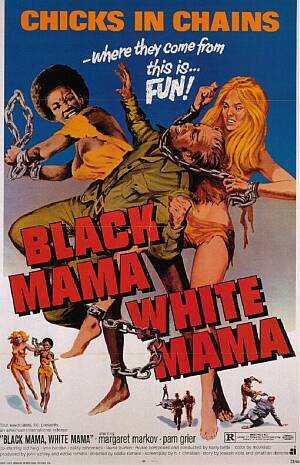 The biggest shock this has to offer is likely the opening credit, “based on an original story by Joseph Viola and…
The biggest shock this has to offer is likely the opening credit, “based on an original story by Joseph Viola and…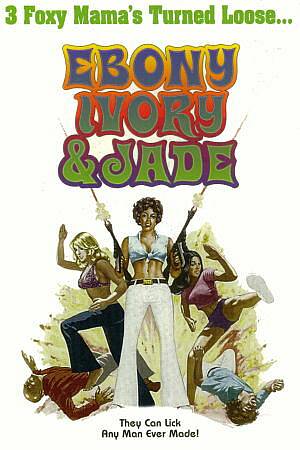 As well as its questionable use of the apostrophe, the cover kinda implies that three girls are involved here, which is only true for a small fraction of the running time. It starts off with
As well as its questionable use of the apostrophe, the cover kinda implies that three girls are involved here, which is only true for a small fraction of the running time. It starts off with  One of the primary rules of exploitation cinema, is never to trust a movie with painted box-art. And, verily, no scene like the picture at right occurs in the film. Indeed, the whole film is sold on sizzle rather than steak, and will probably leave you feeling more than a little hungry. Verrell looks the part, though her slicked-back hair is rather too cliched and obvious, and she does appear to be doing her own action. Her lack of acting ability is painfully obvious, however, and Santiago is wise to keep her dialogue to a minimum.
One of the primary rules of exploitation cinema, is never to trust a movie with painted box-art. And, verily, no scene like the picture at right occurs in the film. Indeed, the whole film is sold on sizzle rather than steak, and will probably leave you feeling more than a little hungry. Verrell looks the part, though her slicked-back hair is rather too cliched and obvious, and she does appear to be doing her own action. Her lack of acting ability is painfully obvious, however, and Santiago is wise to keep her dialogue to a minimum.